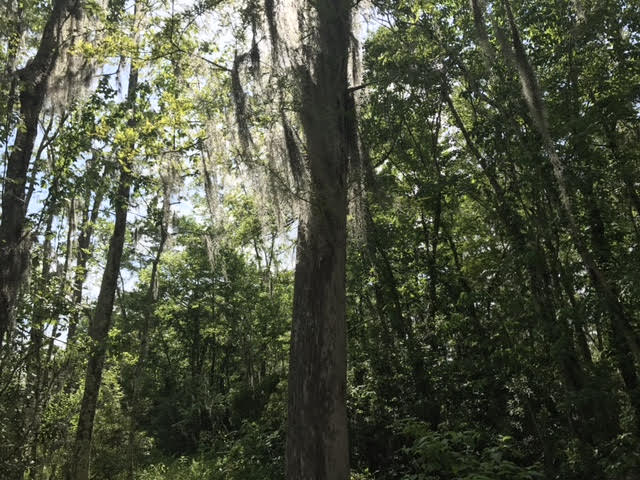En route to New Orleans, we stopped over at the Barataria Preserve in the Jean Lafitte National Historical Park. We were on a mission – spot the elusive American alligator in its natural habitat. Well, I suppose it was mainly my mission, and I forced everyone to become as enthused as I was. I worked at a zoo for five years so, naturally, it's my duty to throw around words like osteoderms, death roll, and Steve Irwin’s signature crikey! Rest in Peace, Steve. Unfortunately, however, we saw no gators that day. And, truth be told, the bayou trees were slightly underwhelming, since all the largest cypresses were cut down about a hundred years ago (humans ruin everything). But there is hope, yet – Andrew promises we’ll take a swamp tour when we head west into Cajun country. I’m going to hold him to that.
But, lack of gators aside, venturing into the mini-bayou was the perfect transition from Grand Isle to New Orleans. It created the ambience necessary for reading Anne Rice’s Interview with the Vampire.
Stepping into a Louisiana swamp is like stepping through time. Prehistoric-looking ferns brush your arm as you labor through the stickiness of the hot air. The verdure is thick and lush. Only a little white light ekes through from above, playing shadow games with the Spanish moss, which hangs lazily from branches like a woman’s hair. There are things that chirp and groan in the brush, hidden always from view. Even the water, completely covered in algae, provides countless hiding places for those things that chirp and groan. Or, more startlingly, the things that silently lurk. And I’m not just talking about gators. The early French settlers here told stories of the Rougarou, a creature that takes the form of a man by day but, by night, peels back its skin and turns into a hairy, ravenous beast that roams the swamp looking for prey. A French swamp werewolf, if you will. Laugh all you want, but I guarantee you wouldn’t be so smug if you were alone at night in the Barataria Preserve and you heard a rustle in the bushes. I was there at two in the afternoon with the eight other Bookpackers, when something scampered across my foot. I almost hit the deck. It was a 4-inch-long lizard, in case you were wondering.
The culprit.
The Rougarou, alligators, and 4-inch-long lizards had certainly made me jumpy, but it was more than that. I had begun reading Interview with the Vampire. I could so clearly visualize Louis and Lestat, our two beautiful and blood-thirsty protagonists, hunting runaway slaves here.
“He sank to his knees, and Lestat fed fast as the other slaves came running...it was as if we were black insects utterly camouflaged in the night, watching the slaves move, oblivious to us, discover the wounded man, drag him back, fan out in the foliage searching for the attacker.”
If the lights and licentiousness of New Orleans provide the place where Louis and Lestat can be elegant, well-dressed Creoles, the dark primitiveness of the swamp provides the place where they can be true beasts of the night. Though, I don't think Louis would care much for that description.
Much like our vampire friends, our journey is far from over here in the cypress swamp. I hear a solo trumpet player in the distance, singing out, staccato and effervescent and joyous. Purple, green, and gold beads drip from tree branches and street lamps. At long last, New Orleans.
MEAL OF THE MOMENT: GUMBO
There was only one thing that could free me from my swamp jitters. What better first "Meal of the Moment" than gumbo? We stopped at Boutte’s Bayou Restaurant in Lafitte (by the way, if you don’t know who Jean Lafitte is, you should look him up and possibly write to Steven Spielberg or Ridley Scott. I have no idea why they haven’t made that movie yet). Anyway, GUMBO.
Gumbo, for those of you unaware of its sensational charms, is a stew, born right here in southern Louisiana a couple centuries ago. There are several different varieties, and I would never claim to understand what constitutes the perfect gumbo, but the one I had at Boutte’s was pretty damn good. It was of the Cajun variety, containing chicken, shellfish (including, of course, crawfish and shrimp), andouille sausage, rice, and various veggies. I had it with buttered French bread. Don’t tell New England clam chowder I cheated on it. But is it really cheating if we were on a break?
Gumbo is the official dish of Louisiana for a reason. The very creation of the stew represents the mingling of traditions that have come to define the state and, in particular, New Orleans. Gumbo is influenced by Spanish, West African, and French culinary practices, just as the city is influenced by these very same cultures. As we head into New Orleans, the concept of "Frenchness" will become vital, not only in contextualizing Interview with the Vampire (as well as The Awakening), but in understanding each sight, sound, and smell of the Big Easy.






